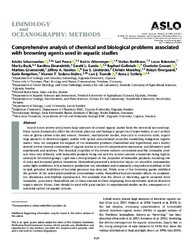Comprehensive analysis of chemical and biological problems associated with browning agents used in aquatic studies
Bertilsson, Stefan
Bolender, Lucas
Buck, Moritz
Einarsdóttir, Karólína
Groeneveld, Marloes
Lindström, Eva S.
Manthey, Christin
Övergaard, Robyn
Rengefors, Karin
Sedano‐Núñez, Vicente T.
DOI: https://doi.org/10.1002/lom3.10463
Persistent URL: http://resolver.sub.uni-goettingen.de/purl?gldocs-11858/9915
Persistent URL: http://resolver.sub.uni-goettingen.de/purl?gldocs-11858/9915
Scharnweber, Kristin; Peura, Sari; Attermeyer, Katrin; Bertilsson, Stefan; Bolender, Lucas; Buck, Moritz; Einarsdóttir, Karólína; Garcia, Sarahi L.; Gollnisch, Raphael; Grasset, Charlotte; Groeneveld, Marloes; Hawkes, Jeffrey A.; Lindström, Eva S.; Manthey, Christin; Övergaard, Robyn; Rengefors, Karin; Sedano‐Núñez, Vicente T.; Tranvik, Lars J.; Székely, Anna J., 2021: Comprehensive analysis of chemical and biological problems associated with browning agents used in aquatic studies. In: Limnology and Oceanography: Methods, Band 19, 12: 818 - 835, DOI: 10.1002/lom3.10463.
 |
Dokument öffnen: |
Inland waters receive and process large amounts of colored organic matter from the terrestrial surroundings. These inputs dramatically affect the chemical, physical, and biological properties of water bodies, as well as their roles as global carbon sinks and sources. However, manipulative studies, especially at ecosystem scale, require large amounts of dissolved organic matter with optical and chemical properties resembling indigenous organic matter. Here, we compared the impacts of two leonardite products (HuminFeed and SuperHume) and a freshly derived reverse osmosis concentrate of organic matter in a set of comprehensive mesocosm‐ and laboratory‐scale experiments and analyses. The chemical properties of the reverse osmosis concentrate and the leonardite products were very different, with leonardite products being low and the reverse osmosis concentrate being high in carboxylic functional groups. Light had a strong impact on the properties of leonardite products, including loss of color and increased particle formation. HuminFeed presented a substantial impact on microbial communities under light conditions, where bacterial production was stimulated and community composition modified, while in dark potential inhibition of bacterial processes was detected. While none of the browning agents inhibited the growth of the tested phytoplankton Gonyostomum semen, HuminFeed had detrimental effects on zooplankton abundance and Daphnia reproduction. We conclude that the effects of browning agents extracted from leonardite, particularly HuminFeed, are in sharp contrast to those originating from terrestrially derived dissolved organic matter. Hence, they should be used with great caution in experimental studies on the consequences of terrestrial carbon for aquatic systems.
Statistik:
ZugriffsstatistikSammlung:
- Geographie, Hydrologie [454]
This is an open access article under the terms of the Creative Commons Attribution‐NonCommercial License, which permits use, distribution and reproduction in any medium, provided the original work is properly cited and is not used for commercial purposes.

